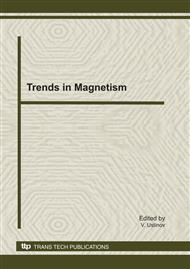p.3
p.15
p.23
p.27
p.31
p.35
p.39
p.43
p.47
Manganese-Doped CdGeAs2, ZnGeAs2 and ZnSiAs2 Chalcopyrites: A New Advanced Materials for Spintronics
Abstract:
Based on the Mn-doped chalcopyrites CdGeAs2, ZnGeAs2 and ZnSiAs2, new dilute magnetic semiconductors with the p-type conductivity were produced. Magnetization, electrical resistivity and Hall effect of these compositions were studied. Their temperature dependences of magnetization are similar in form in spite of a complicated character, which is controlled by the concentration and mobility of the charge carriers. Thus, for T < 15 K, these curves are characteristic of superparamagnets and for T > 15 K, of a frustrated ferromagnet. In compounds with Zn these two states are diluted by a spinglass-like state. This specific feature is ascribed to attraction of Mn ions occupying neighboring sites and to competition between the carrier-mediated exchange and superexchange interactions. The Curie temperatures of these compounds are above room temperature. These are the highest Curie temperatures in the AIIBIVCV2:Mn systems.
Info:
Periodical:
Pages:
31-34
Citation:
Online since:
December 2010
Price:
Сopyright:
© 2011 Trans Tech Publications Ltd. All Rights Reserved
Share:
Citation:


